Bourne Road
I was born at number 7 Bourne Road in December 1937.
Bourne Road was almost a lane, with just 6 houses built I assume around 1936/7. The east side was a field. Then there was a war-time 'tank-trap' (very large ditch), another field and eventually the Bourne stream. Photos show the road and the field.
I also have photos of a Funfair set up in the field
On the west side of Bourne Road was Stone’s Field (between the houses and the main road).
There were three pairs of houses which were occupied by:
1. Mr & Mrs Frank Belcher (number 5)
2. George & Dorothy Glading (number 7)
3. Mr & Mrs Passmore, sons Ron, Mick, Roy
4. Mr & Mrs Fred Allright?
5. Mr & Mrs Walt Chamberlain, sons Sid & ?Peter and daughter Gytha (who was about same age as me)
6. Mr & Mrs Livingstone, daughter Anne
The houses had gas lighting – and not in all rooms – going to the loo needed a torch. Heating was by coal fire - there were fireplaces in the main living room and the second downstairs room (used as a sitting room or a dining room). The bedrooms had fireplaces but it was very rare to use them. Off the kitchen was a passage to the back door, with a coal bunker. The kitchen and bathroom didn't have running hot water - water for a bath was heated in a big copper vat with a gas ring underneath (also used for the clothes wash) and ladled out into the bath.
There used to be a 'Muffin man' who came round. He walked down Bourne Road, with a sizeable wooden tray on his head and a loud hand-bell to announce his arrival. Allegedly he walked all the way from Reading.
The War
Walt Chamberlain was in the Home Guard. He once let me fire his rifle – the recoil really hurt my shoulder. He raised pigs too – it was great fun helping them get loaded on a lorry to be taken away for slaughter.
We had two evacuees billeted on us. Two girls 3 or 4 years older than me (Norma and Valerie Knight) from Willesden (north-west London). I can’t remember exactly how long for.
I can remember air-raid warnings, and spending time all sitting in the space under the stairs. Though I don't think any actual bombs fell anywhere near.
And going to look at crashed aircraft (eg over The Marsh and one just the other side of Tidmarsh) and wondering at the twisted aluminium. George, as a fireman, went to these crashes and used to say how horrible it could be (finding parts of the bodies of crew).
I have hazy memories of lorries full of troops – including ones full of ‘yanks’ dispensing packets of gum to the kids
Towards the end of the war the river meadows (by Whitchurch Bridge) were full of soldiers. We watched them construct a bridge on pontoons over the Thames (I assume this was practice for D-Day).
Once or twice we had the luxury of a food-parcel - from I think South Africa. A tin of sliced peaches was an amazing treat.
Schools
I first went to “Miss Grist’s” – a small nursery held in the Village Hall up the lane opposite the Co-op store.
Then I went to Pangbourne School, which was up Basildon Hill, at the far end of the village. I suppose it was quite a fair way to walk each day. Everyone who went there probably feared the headmaster, known to all as “Spotty” Townsend (why?). Mrs Townsend did the cooking for the school. Mr Simmonds was the caretaker. Miss Annetts and Miss Garnett taought the infants. Mr Ingledew, a very nice man, taught Geography and Miss Reeves was the PE teacher.
I can also remember having piano lessons with Miss Franklin. My mother was very keen (as she was a good pianist) but I’m afraid I was reluctant, didn’t really do any practice and so it all faded.
In 1949 I passed the “Eleven-Plus” and then went to Wallingford Grammar School. A bus started in Purley, picked us up in Pangbourne Square, then went to Upper Basildon, down to Streatly, then over the river to Goring and up to Wallingford.
Pangbourne Village
The Recreation Ground was well used – I can remember large Village Shows, with big marquees full of produce.
The football team was quite successful – in fact quite sizeable crowds came to watch. I can even remember going to an away match to watch some cup-tie.
The village annual Remembrance Parade was quite big – several bands and lots of groups marching. The parades assembled in Bourne Road and Reading Road.
Trains
Although our house in Bourne Road was quite near to the railway (the main line from London to Bristol and the West) we got used to all the trains. They were all steam trains of course, and in the summer the chimney embers regularly set fire to the embankments.
Naughtily we used to go over the railway line to the Rec (much quicker than going round through the village). And sometimes put pennies on the track, to recover them all squashed flat.
I can remember going up to Pangbourne Station train-spotting. Once I was very lucky when the driver of a steam engine doing some shunting work there let me climb up into the cab and have a ride along past our house and back again. The fire was very hot… Again something that wouldn't happen today.
Football
My father was very keen, and used to go and watch Reading FC regularly. From I suppose 8 years old or so I often went with him. Quite a number of people from Pangbourne used to regularly go, standing behind the Tilehurst goal.
For a long time we used to travel with ‘Bomber’ Lee. Bomber was a local carrier, whose lorry had a row of seats down each side at the back. We all had to climb up very high into the back, then he latched the tail-board up and off we went to Elm Park. For big matches the lorry was jam packed with people standing too – probably distinctly unsafe.
TV
The first television I think I saw was at ‘Crasher’ Colliers, who ran the garage in Reading Road (his son was at school too). It must have been the Queen’s wedding (1947).
East of Bourne Road
In the late 40s, I think, Bourne Road became a proper tarmacked road and was extended all the way up to the Bourne stream. The first half was pebbled-dashed (bright yellow) council houses, then lots of prefabs. This meant of course that that section of the tank trap was filled in.
The stream I call the Bourne (was that ever it's real name?) ran from Sulham. There was a path alongside it, following it down to where it ran into the Thames. It wasn't that deep (rarely more than a couple of feet) so was ideal for kids to play in, throw pieces of wood in, look for fish.
On Reading Road, just east of Bourne Road, was Collier's garage. Crasher Collier got his name through his hobby of riding grass-track motorbikes. So between normal garage jobs you could hear lots of racing engine testing.
Across from Collier's, was the start of fields leading towards the Pang and Sulham Lane. (this is where the Texaco filling station is now). There was a concrete 'Pill Box' there, defending the Reading Road, and various excavated ditches (extension of the tank trap) which stayed full of water. In the cold winter of 1947 they had good strong ice cover.
READING ROAD
Wright's Nursery was opposite Bourne Road. My father, George, was an orphan who was originally apprenticed as a 'big-house' gardener. He came to work in Pangbourne at Wright's Nursery. It was owned by the Wright family - I think this consisted of 'old man' Wright and his two sisters. There were 7 or 8 long greenhouses and George did most of the running of the propagating, growing and so on. During the war in particular the nursery concentrated on food crops such as tomatoes. Later on the nursery was taken over by George Page and his wife.
The western corner of Bourne Road and Reading Road was an open field, which we called Stone's field. In this field was a hand water pump – lovely fresh cold water. Later on the Stones built a bungalow there.
Between the field and the Police Station was a pair of semi-detached houses. The one on the Reading side was occupied by the Wyatts, of the family that ran the bakery in the village. The other was lived in by the Stones - David was 2 or 3 years older than me.
The Police Station grounds went back almost to the end of the Belcher's garden. There were always enormous piles of heating coke - great fun to climb and slide in (until chased away). At the end of the grounds were kennels to house lost dogs of the area. They used to whine and bark night and day. Upstairs in the Police Station was a snooker table and recreational club for the policemen. - And their friends - my father used to say that the one place you could get alcoholic drinks 'out-of-hours' in Pangbourne was at the Police Station.
Opposite the Stone's house was the village dentist. Mr Papworth's practice was held in fear and trembling. Not surprising, because the drills were big and coarse, driven by foot treadles. And I can't remember anaesthetics being common, apart from extractions.
Further towards the village from the Police Station was a garage, with behind the garage the premises of Stone's mill. Flour was ground here, with dust in the air all around.
Then there was the Coop. This was a proper old grocery shop. A long marble counter with everything you needed behind the counter or in front of it in bins. Lovely smells throughout the shop. There were whole sides of bacon hanging up. If you wanted dried fruit it was measured out for you into small paper cones. Salt came in loaf sized bricks, which you took home and sawed off salt as and when you needed it.
Next to the Coop, back from the road, was a Forge. Lots of stock bars and part finished work lying around - and again interesting smells too.
Opposite the Coop was the alley to the original Village Hall (which is where Miss Grist's nursery school was held.) The Hall was used for all the usual village activities. It became the home of a travelling cinema, known to all as The Bijou's. Once a week it set up and gave one, two or even three showings. The whole village seemed to go.
I seem to remember that there was also a fish&chips shop (not much more than a shed) up the alleyway too.
The Methodist Church was along from the Coop. David Stone used to play the organ there. The church had a separate function room, used for parties, plays and so on. It had marvellous long wooden movable pews.
The Fire Station is now the Library. During the wartime my father wasn't fit enough to be called up, but became a fireman at Pangbourne firestation and served for many years as a a “Retained Fireman” both during and after the war. At some point the Fire Brigade installed a very large bell on the landing of our house in Bourne Road, directly wired to the Station. When there was a call-out everybody very definitely got woken up.
I can remember learning to play Bar Billiards at the Fire Station, and used to go along there with Dad whenever he had to go in for clearing-up or paperwork and have a play.
Burley's was a sweet shop, full of glass jars full of very tempting things.
The SQUARE
W.H.Smith's, the newsagents, had a front section for papers, then doors into the main shop. This allowed the front section to open extra early in the mornings for the newspaper sales. A very nice wooden staircase lead to a first floor, which became the Lending Library (no free council-run library in those days). My mother became the librarian - which was useful as I could drop in on the way home from school.
Colebrook's fish shop is I think now part of the Sommerfield store.
Just over the Pang was Tidbury's. A magic shop selling cigarettes, bits & pieces , and electrical items.
Back in the 40's your only home entertainment was the radio. And most radios weren't driven by mains electricity (because a lot of houses didn't have mains anyway). So your radio set depended on two batteries. One was the 'high tension' battery made up of a multitude of dry cells similar to today's 'AA' batteries - up to 120 of them. The other was the low tension battery that drove the heater filaments of the electronic valves in the radio (this was all way before transistors). This low tension battery was a 'wet cell' called a lead acid accumulator - it was a glass jar about the size of a 200 gm. coffee jar, full of acid. If you used the radio much you quickly drained the low tension battery. So many families owned at least two - one in the set and the other on charge at Tidbury's. A back room at Tidbury's housed benches full of low tension cells on charge. And an unforgettable smell of hot acid.
Later on, in the 50's I used to work there And they even started selling records.
Amongst the shops just past Tidbury's were:
· Mr Abbott, the shoe repairer
· one run by the Miss Oram at 4 High Street.
· Mrs Cork's
· And Harold Lever ran a greengrocery shop? This also sold soft drinks - I actually still have an old glass 'pop' bottle with internal marble stopper, moulded with the H.Lever Pangbourne name.
Opposite Tidbury's were
· Harper's Dairy, run by Mr Harper and his 3 sisters.
· Hutchinson's, at nos. 1 and 3, was a grocer's managed by Mr Fisher.
The main thing I remember about these and the other village shops was that many of them sold the same things (groceries, fruit and so on). So, unlike today, there was a lot of choice. One of them sold delicious (to us children), cheap, fruit flavoured ice lollies. As no-one had fridges at home an ice lolly was a treat. But I can't recall which shop it was
The PANG
In the summer the main destination was the River Pang meadow. There was a proper “Bathing area”, with steps down, and a changing hut (though the swimming area was partially silted up and the hut got demolished). It was a great place for learning to swim.
There were three bridges over the Pang, upstream from the bathing area. Two made out of old railway lines and the one in between was a wider wooden one (possibly) capable of carrying farm vehicles. From the tall tree just below the lower bridge was a rope, for swinging out over the river and dropping off.
People
Harry Anderson was the village Road sweeper. Out in all weathers, he knew everybody.
The Fuller family were numerous, and into many things. They were builders and so on - and stalwarts of the Pangbourne Brass Band.
see also document MemoriesGladingFamily1940s
Images
The original Bourne Road, looking towards Reading Road.
Wright's Nursery in the background.
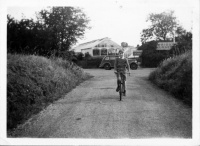
Click here for larger picture.
The field to the east of Bourne Road.
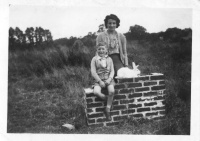
Click here for larger picture.
The Funfair in the field to the east of Bourne Road.
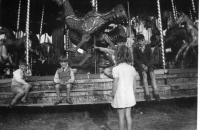
Click here for larger picture.
Pangbourne School Class
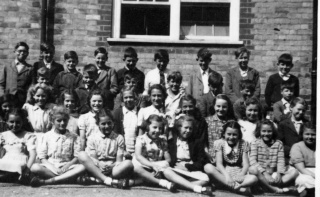
Click here for larger picture.
Pangbourne School Photo of 1949
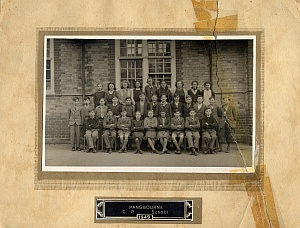
Click here for bigger image - and KEY to who is who...
H.Lever Bottle.
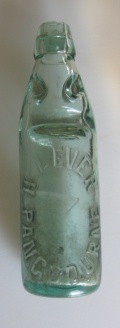
Click here for larger picture.
Pangbourne Village Guide c. 1949.
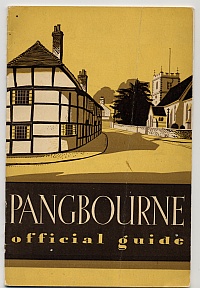
Click here for larger picture.
Adverts from Pangbourne Village Guide c. 1949.
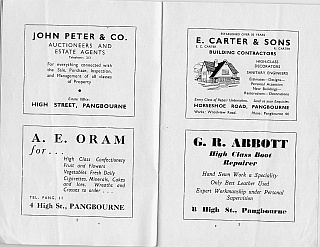
Click here for larger picture.
Bourne Road from the air (probably the 50s in fact?).
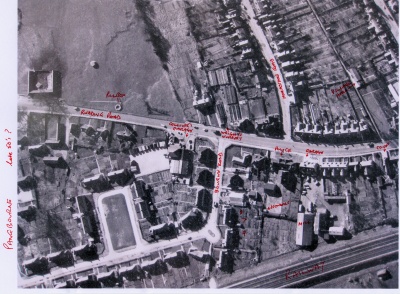
Click here for larger picture.
-----
---
